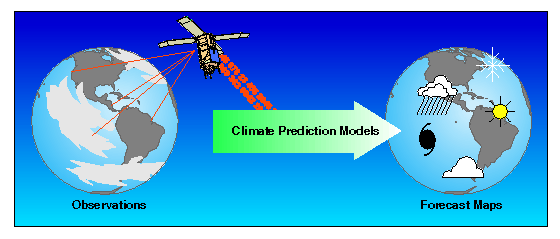

Today, short-term predictions based on El Niño are becoming routine, but forecasting of decades-long changes in climate are still in its infancy. The reason, says Wallace, is that it is a puzzle made up of many diverse parts. They have names that trip the tongue so easily they could be flowering plants or grunge rock groups: the Pacific Decadal Oscillation, the North Atlantic Oscillation, and the Tropical Atlantic Dipole. All involve patterns of atmospheric pressure and winds that reverse direction every few decades. These reversals seem to be the markers for decades-long recurrences, whether bountiful or brutish, such as harsh winters in Europe, droughts in sub-Saharan Africa, or strong cyclones in the Gulf of Alaska.

Reliable data are the key to medium and
long-term predictions. Graphic courtesy Candace Gudmunson, UW Dept. of
Atmospheric Sciences.
Between 1925 and 1945, for example, the winters in the Pacific Northwest were mild and the winds over the Gulf of Alaska were strong, conditions that UW Fisheries Professor Robert Francis believes were responsible for the abundant catches of Alaska salmon during those years. The following 30 years had exactly the opposite conditions. But starting around the late 1970s, winters turned milder again, winds over the Gulf strengthened and the Alaska salmon harvests improved dramatically, even surpassing those back in the '20s through the '40s.
Can we look forward to more mild winters and inexpensive Copper River sockeye salmon? The difficulty for scientists is recognizing such long shifts while they are happening and not five to 10 years after they have occurred. "It's hard to distinguish them from shorter-term changes such as those caused by El Niño," notes Wallace, a lean, genial man who is the UW's newest member of the National Academy of Sciences.
One key to developing accurate predictions is the ocean, which is the flywheel, or memory, of climate. The ocean has a very long memory, partly because it is so sluggish--ocean currents are typically slower than the winds by a factor of 100--and partly because of its enormous heat storage. A layer of ocean water 10 feet deep has more heat capacity than the entire area of the atmosphere above it.
Computer simulations of the climate offer the hope of making sense out of this vast array of data so that we will ultimately be able to recognize and perhaps even forecast these decades-long shifts, says Wallace. As an example of the different ideas that might one day provide a basis for such predictions he cites teleconnections, the theory that abnormal climatic conditions in far-flung regions of the globe are linked via the jetstream.
Long-Term Predictions: The Threat of Global
Warming
Return to the Beginning of "Reading the
Skies"
Send a letter to the editor at columns@u.washington.edu.